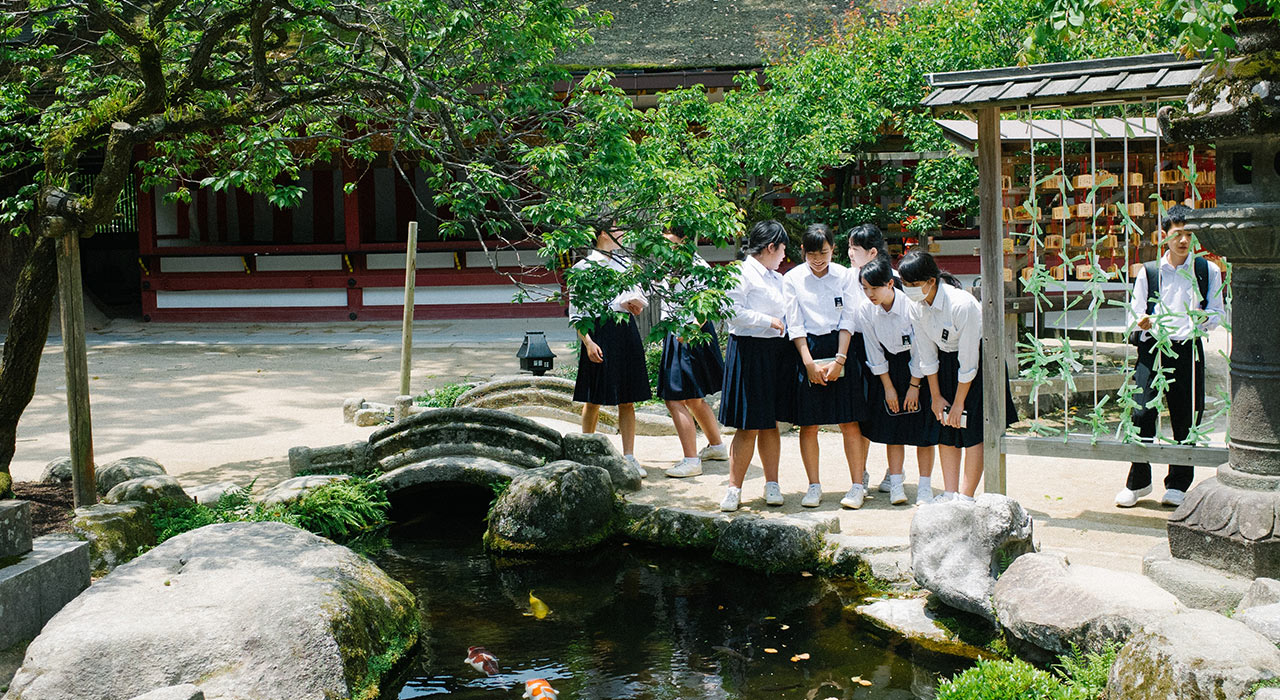How to Say “Student” in Japanese – And 70+ More Japanese Words to Help You Follow the Path of the Sensei
Are you a new student in Japanese class? Or looking to find a Mr. Miyagi to your Karate Kid?

Maybe you want to study abroad in Japan or apply for the JET program soon and you’re looking for a way to start learning the Japanese language. Well then, tie on your hachimaki, and let’s get to work!

Let’s look at today’s lesson plan:
- Learn how to talk about being a student in Japanese
- Talk to your classmates — the senpai and kouhai at your school
- How to talk to your sensei with respect
- What it’s like in a Japanese classroom
- Japanese school vocabulary you need to know before studying abroad
By the end of this, you’ll be on the path to Japanese mastery!
“Student” in Japanese – Gakusei
The Japanese word for “student” is 学生 (gakusei). So you, right now, are officially a 学生 of the Japanese language!
But gakusei is a bit of a generic term for “student.” It’s used to talk about any kind of student. Depending on your school level, the word changes:
- 大学生 (daigakusei) – “College student”
- 高校生 (koukousei) – “High school student”
- 中学生 (chuugakusei) – “Middle school student”
- 小学生 (shougakusei) – “Elementary school student”
If you want to say “I’m a student in Japanese class” you can say 日本語のクラスの学生です。(Nihongo no kurasu no gakusei desu) Or, you can tell somewhere where you go to school: 東京大学の学生です (Toukyou daigaku no gakusei desu). Just change Toukyou daigaku to your school name.
Trying to explain which class you’re in? You use this phrase: クラス_にいます (kurasu _ ni imasu). For instance, クラス3の2にいます. “I’m in class 3-2.”
If you want to ask someone else if they’re a student, you attach the question particle か to make it a question. 学生ですか (gakusei desu ka) means “Are you a student?” in Japanese.
Senpai and Kouhai
So, what is “senpai”? The definition of senpai is anyone who is in a class above your own. So, if you’re in 10th grade, and you’re talking to someone in the 11th grade, they’re your senpai.
The meaning of senpai also takes on a whole new life in anime, where it’s most often heard. It’s usually used in anime by girls talking about their crush on an older boy in a class or two above them. It’s a very common trope in anime and manga and has inspired tons of memes about girls trying to get their senpai to notice them.

Now… Is it sempai or senpai? You’ll sometimes see it romanized both ways. That’s because it’s pronounced more like “m” but there is no single letter “m” in the romanization system of Japanese, called romaji. It’s a bit confusing, but basically, there is no difference. In Japanese, it’s written 先輩 (kanji) or せんぱい (hiragana). The character ん is romanized as either “n” or “m”, but usually takes on more of an “m” sound, like in senpai and ganbatte (“good luck”).
As for kouhai, that’s the term for an underclassman. So you, as the 10th grader in our example, would be a kouhai to your senpai in 11th grade. Likewise, a 9th grader is your kouhai.
The term kouhai isn’t used often though because it can come across a bit condescending. You never want to portray yourself as superior in Japanese, and the use of kouhai gives off that vibe.
When talking to your classmates in school, you can talk to those in your class with casual speech. But that changes in the senpai-kouhai dynamic. The level of formality changes depending on your relationship with the other person. You may be expected to use 敬語 (keigo, honorific language) with your senpai.
It also affects how you interact because your place in society and your relationship to others is extremely important to Japanese people. So, if you’re a kouhai, you would want to talk more formally to your senpai. But you might also have extra classroom or after-school club (called 部活, bukatsu) duties as the kouhai. And you’ll typically be expected to follow the example of your senpai. Kouhai are not the leaders here.
This dynamic usually begins around junior high, though. Before that, in elementary school, it’s common to be on more friendly terms with older students. You’ll often hear -ちゃん (-chan) or -くん (-kun) used with the person’s first name.
But this type of dynamic continues on into college, work, and other life situations where someone has more “experience” than you. Tofugu has a whole in-depth article about how the nature of senpai changes through life.
“Master” in Japanese – Sensei
The word for “teacher” in Japanese is 先生 (sensei). It also means “master.” The sensei kanji breaks to down mean “The one who comes before.” So, they’re a “master” or “teacher” because they have more life experience than you.
That means that sensei can also be used in more ways than addressing your teacher. It’s for anyone you respect, who has more experience or is teaching you something outside of a classroom. It’s also used for tutors, doctors, politicians, or even artists and writers.
When you get into sports and fitness, the dynamic can sometimes change. For instance, in sports, you may use コーチ (kouchi) like you would call someone “coach” in English. Martial art teachers are still 先生 though, as are yoga teachers.
Essentially, sensei is used for anyone you respect for their knowledge or talent, whether they’re a “teacher” or not.
You can call someone sensei or attach it to their last name, like 田中先生 (Tanaka-sensei).
Sometimes, you’ll hear sensei used sarcastically or in a casual, funny way. For instance, Google is sometimes called グーグル先生 (gu-guru-sensei) because… Well, Google knows all.
When talking to your teacher, it’s important to show proper respect. You’ll address your sensei with honorific speech, and talk about yourself with humble speech. And when leaving the classroom, you’d bow facing the inside of the classroom and tell your teacher 失礼いたしました (shitsure itashimashita), which is past tense keigo speech for “Thank you for your hard work today.”
What’s a Japanese School Like?
Elementary – High School in Japan
Japanese kids in school have quite a different experience from other parts of the world. For instance, school buses aren’t a thing. Most kids walk or bike to school if they live close. If they don’t live close by, they take public transport like a train. This means many kids — especially high schoolers — have quite the commute to and from school.
Plus, kids in Japan have a ton of pressure to pass entrance exams. Because mandatory schooling is only up to 9th grade in Japan, high schools are like colleges. They require students to pass an entrance exam to be admitted into the high school of their choice. The same is true for universities — but you can only apply to certain universities based on which high school you attend. So the pressure to get a good education and job starts in junior high, and many attend cram schools to prepare.
The way they break up the school years is a bit different, too. Elementary school is grades 1 – 6, junior high is 7 – 9, and high school is 10 – 12. Most junior and high school students have to wear the famous Japanese school uniform, although elementary school kids may not.
And the school year is different, too! The Japanese school year actually begins in April and ends in March. But even though Japan follows a year-round system, they have three breaks throughout the year.
The biggest difference? Kids stay in one classroom for most everything. So, they have one homeroom, which they’re in charge of keeping clean. Every day at the end of the day, students pitch in to clean the room — including scrubbing the floors. They store all their belongings with them in their desk or room, so they don’t have lockers except for shoes. (They still take off their shoes and switch to house slippers called 上履き, uwabaki, like they would at home!)
They also eat in their homeroom, so there’s no cafeteria setting here. The teachers for different subjects come and go, and have their own teacher’s room where all the teachers can work in peace between classes.
Last up, there’s also big school festivals like Sports Day (運動会, undoukai). If you watch any school-age anime, you’ve seen this celebration for sure. You’ll also find Japanese-style floor toilets in most school bathrooms, and no A/C — yes, really.
College Life in Japan
University is when Japanese students finally get some freedom. They don’t have to wear school uniforms anymore. The senpai-kouhai dynamic lightens. And most college students live on their own in an apartment. And while it’s hard to get into college because of the intense entrance exams, there’s actually less academic pressure once you’re in. You may not even have to show up for class, and most classes don’t have students do many projects or participate.
So for many, college is actually the one true time Japanese students can take it easy. Many spend their time engaging in school activities, or drinking and playing video games. Because after college, the Japanese workforce life gets intense again.
A List of Japanese School Vocabulary
Now, here’s a list of Japanese vocabulary and phrases used in the classroom. If you plan on attending a Japanese school, teach abroad, or start going to a Japanese class, these are important to know.
In Your Backpack
- Ransel (a type of school backpack) – ランドセル (randoseru)
- Pen – ぺん (pen)
- Pencil – えんぴつ (enpitsu)
- Eraser – 消しゴム (keshigomu)
- Paper – 紙 (kami)
- Homework – 宿題 (shukudai)
- Bento – 弁当 (bento)
- Scissors – 鋏 (hasami)
- Calculator – 電卓 (dentaku)
- Pencil case – 筆箱 (fudebako)
- Notebook – ノート (no-to)
- Page – ページ (pe-ji)
- Textbook – 教科書 (kyoukasho)
- Dictionary – 辞書 (jisho)
At School and In the Classroom
- Class – クラス (kurasu)
- Classroom – 教室 (kyoushitsu)
- Morning meeting – 朝礼 (chourei)
- Uniform – 制服 (seifuku)
- Lunch – ランチ (ranchi)
- School lunch – 給食 (kyuushoku)
- Recess – 昼休み (hiruyasumi)
- Cleaning time – お掃除 (o-souji)
- Teacher / Lecturer – 教室 (kyoushitsu)
- Supervisor / Homeroom teacher – 担任 (tannin)
- Principal – 校長先生 (kouchou-sensei)
- School nurse – 看護師 (kankoshi)
- On-duty (The teacher who, that day, has to maintain the school, unlock and lock up, etc) – 当番 (Touban)
- Ceremony – 式 (shiki)
- Graduation – 卒業 (sotsugyou)
- Desk – 机 (tsukue)
- Chair – 椅子 (isu)
- Practice – 練習 (renshuu)
- Blackboard – 黒板 (kokuban)
- Ruler – 定規 (jougi)
- Cram school – 塾 (juku)
- Library – 図書館 (toshokan)
- Bathroom – トイレ (toire)
- Exams – 試験 (shiken)
- Tests – テスト (tesuto)
- Grade – 成績 (seiseki)
- Vacation – 休み (yasumi)
Japanese School Classes
- Japanese (“Language Arts”) – 国語 (kokugo)
- Japanese (language) – 日本語 (nihongo)
- English – 英語 (eigo)
- Math – 算数 (sansuu)
- Science – 科学 (kagaku)
- P.E. – 体育 (taiiku)
- History – 歴史 (rekishi)
- Art – 美術 (bijutsu)
- Social Studies – 社会科 (shakaika)
- Music – 音楽 (ongaku)
Japanese School Phrases
- Good morning – おはようございます (ohayou gozaimasu)
- Bon appetit – いただきます (itadakimasu)
- Thank you for this meal – ごちそうさまでした (gochisousama deshita)
- Have a nice day – いってらっしゃい (itterasshai)
- Be careful – 気を付けて (ki wo tsukete)
- Please read – 読んでください (yonde kudasai)
- Please write – 書いてください (kaite kudasai)
- Please say – 言ってください (itte kudasai)
- Please listen – 聞いてください (kiite kudasai)
- Please repeat – もう一度お願いします (mou ichido onegai shimasu)
- Do your best / Good luck – 頑張ってください (gambatte kudasai)
From Student to Sensei!
The student in Japanese has grown to become the master! Since you now know about school life in Japan, you’re prepared to study abroad or start applying for a program like JET to teach in Japan.
Ready to learn more about Japanese life? Why not try binging the best Japanese shows to see more of the culture and mannerisms. Or learn Japanese slang to sound like a local.



Social